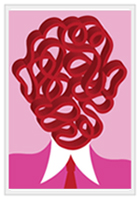
In his recent article in the NYTimes (The New Science of Mind, 9.6.2013), Professor Eric Kandel, asks us to consider the biology of depression. It is his belief that growing understanding of the physical workings of brain disorders, whether psychiatric or neurological, will give us new insights into who we are as human beings.
* * *
Consider the biology of depression. We are beginning to discern the outlines of a complex neural circuit that becomes disordered in depressive illnesses. Helen Mayberg, at Emory University, and other scientists used brain-scanning techniques to identify several components of this circuit, two of which are particularly important.
One is Area 25 (the subcallosal cingulate region), which mediates our unconscious and motor responses to emotional stress; the other is the right anterior insula, a region where self-awareness and interpersonal experience come together.
These two regions connect to the hypothalamus, which plays a role in basic functions like sleep, appetite and libido, and to three other important regions of the brain: the amygdala, which evaluates emotional salience; the hippocampus, which is concerned with memory; and the prefrontal cortex, which is the seat of executive function and self-esteem. All of these regions can be disturbed in depressive illnesses.
In a recent study of people with depression, Professor Mayberg gave each person one of two types of treatment: cognitive behavioral therapy, a form of psychotherapy that trains people to view their feelings in more positive terms, or an antidepressant medication. She found that people who started with below-average baseline activity in the right anterior insula responded well to cognitive behavioral therapy, but not to the antidepressant. People with above-average activity responded to the antidepressant, but not to cognitive behavioral therapy. Thus, Professor Mayberg found that she could predict a depressed person’s response to specific treatments from the baseline activity in the right anterior insula.
These results show us four very important things about the biology of mental disorders.
- The neural circuits disturbed by psychiatric disorders are likely to be very complex.
- We can identify specific, measurable markers of a mental disorder, and those biomarkers can predict the outcome of two different treatments: psychotherapy and medication.
- Psychotherapy is a biological treatment, a brain therapy. It produces lasting, detectable physical changes in our brain, much as learning does.
- The effects of psychotherapy can be studied empirically.
Any discussion of the biological basis of psychiatric disorders must include genetics. And, indeed, we are beginning to fit new pieces into the puzzle of how genetic mutations influence brain development.
Most mutations produce small differences in our genes, but scientists have recently discovered that some mutations give rise to structural differences in our chromosomes. Such differences are known as copy number variations.
People with copy number variations may be missing a small piece of DNA from a chromosome, or they may have an extra piece of that DNA.
Matthew State, at the University of California, San Francisco, has discovered a remarkable copy number variation involving chromosome 7. An extra copy of a particular segment of this chromosome greatly increases the risk of autism, which is characterized by social isolation. Yet the loss of that same segment results in Williams syndrome, a disorder characterized by intense sociability.
This single segment of chromosome 7 contains about 25 of the 21,000 or so genes in our genome, yet an extra copy or a missing copy has profound, and radically different, effects on social behavior.
The second finding is de novo point mutations, which arise spontaneously in the sperm of adult men. Sperm divide every 15 days. This continuous division and copying of DNA leads to errors, and the rate of error increases significantly with age: a 20-year-old will have an average of 25 de novo point mutations in his sperm, whereas a 40-year-old will have 65. These mutations are one reason older fathers are more likely to have children with autism and schizophrenia.
Our understanding of the biology of mental disorders has been slow in coming, but recent advances like these have shown us that mental disorders are biological in nature, that people are not responsible for having schizophrenia or depression, and that individual biology and genetics make significant contributions.
This new science of mind is based on the principle that our mind and our brain are inseparable. The brain is a complex biological organ possessing immense computational capability: it constructs our sensory experience, regulates our thoughts and emotions, and controls our actions. It is responsible not only for relatively simple motor behaviors like running and eating, but also for complex acts that we consider quintessentially human, like thinking, speaking and creating works of art.
Looked at from this perspective, our mind is a set of operations carried out by our brain. The same principle of unity applies to mental disorders.
[Simcha’s note: Other studies show that, alongside “native” biological and genetic tendencies, external traumas and ongoing stress can also cause alterations and modifications to the neural circuits.]
* * *
Eric R. Kandel is a professor at the Mortimer B. Zuckerman Mind Brain Behavior Institute at Columbia, a senior investigator at the Howard Hughes Medical Institute and a recipient of the 2000 Nobel Prize in Physiology or Medicine. He is the author of “The Age of Insight: The Quest to Understand the Unconscious in Art, Mind and Brain, From Vienna 1900 to the Present.”